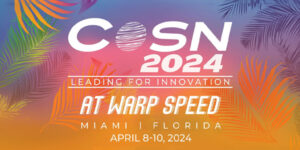This year’s ISTELive 24 EdTech conference put usability front and center! Check out our key takeaways below.
Usability has been recognized as a key factor in EdTech
ISTE, 1EdTech Consortium, CAST, CoSN, Digital Promise, InnovateEDU, and SETDA worked together to establish five Quality Indicators for EdTech and AI Products. The indicators are meant to guide product owners as they create their offering and to assist educators when making quality purchasing decisions.

EdTech products must establish robust data privacy and security measures to protect student and educator data and safeguard against unauthorized access or data breaches.

EdTech product design, implementation, and claims of effectiveness need to be grounded in rigorous research and evidence-based practices as specified by the ESSA Tiers of Evidence.

EdTech products must prioritize accessibility, inclusivity, and equitable design to ensure they are acceptable to learners from diverse backgrounds and with a broad range of learner variability.

EdTech products must be designed to be easily usable by educators and students to ensure a seamless digital experience.

EdTech products must seamlessly connect to other technologies within a school’s digital ecosystem.
ISTE and the other groups are serious about promoting EdTech products that meet the 5 Quality Indicators. The relaunched EdTech Index provides educators with a searchable list of products, showing which of the indicators have been validated by trusted sources. As educators begin to rely on this resource for purchasing decisions it will become even more important for companies to show their commitment to creating quality learning experiences.
We are making a very bold move today. Starting in 2025 ISTE will give priority to exhibitors to participate in our expo floor if they have demonstrated validations aligned to the 5 Quality Indicators.
RICHARD CULATTA AT ISTELIVE 24

In order for EdTech companies be relevant, they will need to take a broader view on what makes their product great for students, teachers, and districts. It cannot simply be a shift in marketing. Forward-thinking companies will assess how their product measures against the Quality Indicators, prioritize improvements, and obtain trusted-source validations that help institutions make informed purchasing decisions.
Foxgroove is a user research and product design agency that specializes in crafting usable experiences. Contact us to learn more.
Usability maturity in EdTech varies significantly
ISTE’s exhibit hall had 1,000+ vendors and a wide variety of booths. Big players like Instructure, Microsoft, and Figma were large, flashy, and staffed with a dozen sales people. Mid-tier booths were nicely designed, while a majority of the vendors had simpler setups with founders at the ready to discuss their product. With ISTE’s big push on the 5 Quality Indicators, we went onto the floor to talk with vendors about product design and the importance of usability. We were heartened, disappointed, and surprised by what we learned.
1. Product usability varied significantly
Whenever possible, we asked for a product overview. We wanted to understand capabilities and do a quick usability assessment. About 15% had nicely designed interfaces that were usable. There were some things we would improve, but they hit the mark. We could tell when a seasoned user experience designer was involved.
The remaining products had varying levels and types of usability, ranging from poor to severe. Many products were visually tired and light years away from away digital interfaces users interact with outside of school. Common usability violations like consistency, scanability, simplicity, and targetability were easily identified. As an industry we need to do better for our kids and educators.
The good news is that small, insightful product changes can lead to big usability improvements. Product teams can move the needle forward by elevating the importance of usability in prioritization discussions and incorporating continuous improvements into the design and development process.
2. Usability is often ‘handled’ by marketing and developers
Some product teams had UX Designers on staff and understood their value. These products tended to be in decent shape from a usability perspective. However, a surprising number of vendors indicated their marketing team or developers (wincing) handled the design of their products. We work with and love both of those groups, but they generally don’t have the UX skills to design a usable product.
Solving this problem is easy: incorporate user experience design into the product lifecycle. User experience designers could be brought in as full-time employees or through a UX-focused design agency. The important success factor is empowering UX with a strong voice at the product management table.
3. Products with the ISTE Seal were clearly promoted
Exhibitors were proud to display their ISTE Seal. We saw the large foam board seal displayed in a number of booths. In most cases, these were medium to large-sized companies. When asked about the seal, companies were eager to tell us about the rigorous standards their product needed to meet. Usability was almost always mentioned as a key component.
Most vendors did not have the ISTE Seal. It was on the radar for some, while others were unsure what it entailed. In both cases we talked about why usability is important in our industry and promoted the seal as a valuable certification. From a business perspective, having the seal is a competitive differentiator. It is starting to become a factor in RFPs and we expect the seal to become a requirement in future.
Foxgroove can conduct a usability evaluation to find, prioritize, and fix your application’s specific usability issues. Contact us to learn more.
There is a need for more EdTech research
The lack of EdTech research came up in a number of panels and presentations. Our favorite session ISTELive 24 was titled “Why is there so little Research on EdTech?” When we arrived at the room about 50 chairs were arranged in a large circle. Dr. Doug Lynch moderated a great discussion that touched on different types of research, institutional vs industry needs, and various factors that effect EdTech research. A great aspect of the session was the variety of view points brought by the attendees. There were usability experts, marketers, K-12 leaders, product owners, academia, and researchers involved in the discussion.
Educational institutions want to know that their investment in a product improves outcomes. Here is our take on the types of EdTech research.
Quantitative Research: One issue facing EdTech is that randomized controlled trials are expensive, can take a long time, and require advanced research expertise. This is the gold standard and provides the best evidence for institutions to make purchasing decisions. While this level of research is needed and should be pursued, most companies can’t afford to test their product at that level. Expecting the most rigorous research makes perfect the enemy of good.
Qualitative Research: As long as the research methodology is sound, smaller studies focused on factors other then score-based outcomes is valuable. One vendor we talked to had a novel approach to reading fluency. They surveyed a set of students before and after a year with their product. They asked students to rate how they felt about reading and were able to show a significant increase in the love of reading at the end of the year! The study did not seek to prove a statistically significant increase in test scores. It did provide meaningful data at a price point and time frame the company could justify.
Usability Research: While many vendors claim their products are usable, there is little-to-no evidence to back up the claims. Usable experiences in EdTech are critical because they facilitate learning flow. Intuitive interfaces maintain focus on the learning experience. Problematic interfaces break the learning flow and can lead to frustration. Methodologies including usability evaluation, interviews, and contextual inquiry can help vendors improve the usability of their products and faithfully market ease of use as a feature.
About our time at ISTELive 24
Foxgroove sent David DeBonis (CEO) and Elana Vetter (Director of Experience Design) to this year’s conference. Our mission was to elevate the importance of EdTech usability. We promoted the value of usable products in every conversation. It was great to see that ISTE values usability as much as we do and even made “Usable” one of their 5 Quality Indicators for EdTech products! We made great connections, learned a lot, and had fun at ISTELive 24. Foxgroove 100% plans on attending next year’s ISTELive 25 in San Antonio!


